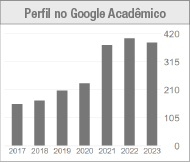O que acontece quando eu olho para você: o espaço íntimo do teatro na prisão para prisioneiros e voluntários
DOI:
https://doi.org/10.5965/14145731033920200110Keywords:
Prison theater, Prison arts, Prison volunteers, Rehabilitation, Arts-in-correctionsAbstract
Apesar dos crescentes estudos sobre teatro e voluntários nas prisões, há pouca pesquisa que olha para a experiência teatral da prisão através dos olhos tanto dos voluntários externos quanto dos prisioneiros-participantes. Este artigo busca tecer as vozes dos coautores para explorar experiências compartilhadas da sala de aula do teatro prisional. Essas experiências – descritas como "mágicas" e "transcendentes" – dependem do voluntariado navegando com sucesso na entrada na prisão. O espaço da sala de aula do teatro prisional torna-se então um refúgio relacional onde tanto os presos quanto os voluntários podem se sentir bem-vindos e aceitos, vistos não como outros, mas como essenciais.
Downloads
References
ABBOTT, J. H. In the Belly of the Beast: Letters from Prison. New York: Vintage Books, 1978.
ABRAMS, L., HUGHES, E., INDERBITZIN, M., & MEEK, R. (Eds.) The Voluntary Sector in Prisons: Encouraging Personal and Institutional Change. London: Palgrave Studies, 2016.
ARMSTRONG, R. Trusting the untrustworthy: the theology, practice, and implications of faith-based volunteers’ work with ex-prisoners. Studies in Christian Ethics, v. 27, n. 3, p. 299-317, 2014.
BREWSTER, L. The impact of prison arts programs on inmate attitudes and behavior: a quantitative evaluation. Justice Policy Journal, v. 11, n. 2, p. 1-28, 2014.
CHELIOTIS, L. (Ed.). The Arts of Imprisonment: Control, Resistance and Empowerment. Ashgate Publishing, 2012.
COHEN-CRUZ, J. Engaging Performance: Theatre as Call and Response. Florence: Routledge, 2010.
CREWE B., WARR, J., BENNETT, P., SMITH A. The emotional geography of prison life. Theoretical Criminology, v. 18, n. 1, p. 56-74, 2014.
CULLEN, F. The twelve people who saved rehabilitation: how the science of criminology made a difference. Criminology, v. 43, n. 1, p. 1-42, 2005.
DILLARD, A. The Writing Life. New York: Harper Perennial, 2013.
DWECK, C. Mindset: The New Psychology of Success. New York: Ballantine Books, 2006.
FESETTE, N. & LEVITT, B. Pedagogies of self-humanization: collaborating to engage trauma in the Phoenix Players Theatre Group. Teaching Artist Journal, v. 15, n. 3-4, p. 100-113, 2017.
FOUCAULT, M. Discipline and Punish: The Birth of the Prison. New York: Pantheon, 1977.
FOUCHÉ, C., & LUNT, N. Nested mentoring relationship: reflections on a practice project for mentoring research capacity amongst social work practitioners. Journal of Social Work, v. 10, n. 4, p. 391-406, 2010.
FREIRE, P. Pedagogy of the Oppressed. New York: Continuum International Publishing Group, 1970.s
GOFFMAN, E. Asylums: Essays on the social situation of mental patients and other inmates. New York: Anchor Books, 1961.
HAMER, K. Navigating boundaries, weaving worlds: U.S. practitioners’ experiences of running theatre programmes in prisons. Cambridge, 2019. Thesis (Masters) – University of Cambridge.
LIEBLING, A. Can human beings flourish in prison? PPT Lecture, London, 29th May, 2012. Available at <http://www.artsevidence.org.uk/media/uploads/evaluation-downloads/can-human-beings-flourish-in-prison---alison-liebling---may-2012.pdf>.
LUCAS, A. Prison Theatre and the Global Crisis of Incarceration. New York: Methuen Drama, 2020.
MORAN D. Carceral geography and the spatialities of prison visiting: visitation, recidivism, and hyperincarceration. Environment and Planning D: Society & Space,
v. 31, n. 1, p. 174-190, 2013.
SIMPSON, E., MORGAN, C., & CAULFIELD, L. S. From the outside in: narratives of creative arts practitioners working in the criminal justice system. The Howard Journal of Criminal Justice, v. 58, n. 3, p. 384-403, 2019.
SMITH, C. What is a Person? Rethinking Humanity, Social Life, and the Moral Good from the Person Up. University of Chicago Press, 2010.
TEWKSBURY, R. & COLLINS, S. Prison chapel volunteers, Federal Probation, v. 69, n. 1, p. 26–30, 2005.
TEWKSBURY, R. & DABNEY, D. Prison volunteers: profiles, motivations, satisfaction. Journal of Offender Rehabilitation, v. 40, n. 1-2, p. 173-183, 2004.
TOFTELAND, C. The Keeper of the Keys. In: SHAILOR, J (Ed.) Performing New Lives: Prison Theater. London: Jessica Kingsley Publishers Ltd., 2011, p. 213-230.
TOMCZAK, P., & ALBERTSON, K. Prisoner relationships with voluntary sector practitioners. The Howard Journal of Crime and Justice, v. 55, n. 1–2, p. 57-72, 2016.
TURNER, V. Liminal to liminoid, in play, flow, and ritual: an essay in comparative symbology. Mediações: Revista de Ciências Sociais, v. 17, n. 2, p. 214–257, 2012.
VAN DER KOLK, B. A. The Body Keeps the Score: Brain, Mind, and Body in the Healing of Trauma. New York, NY: Penguin Books, 2014.
VAN MAANEN, K. Miss Spent: A drama project for young women at the Josephine Butler Unit, HMP Downview. Evaluation Report. Available at: <http://www.clinks.org/assets/ files/Miss%20Spent%20report%20final.pdf>.
ZELON, H. The Shakespeare redemption: Inmates in a Kentucky prison grapple with the truths of human existence. American Theatre v. 18, no. 8, p. 32–135, 2001.
Downloads
Published
How to Cite
Issue
Section
License
Copyright (c) 2020 Urdimento - Revista de Estudos em Artes Cênicas

This work is licensed under a Creative Commons Attribution 4.0 International License.
Copyright Statement
The articles published by the magazine are free to use. The copyright is all assigned to the magazine. The articles whose authors are identified represent the expression from the point of view of their authors and not the official position of the journal Urdimento. The author (s) undertakes whenever publishing material relating to the article published in Revista Urdimento mention the said publication as follows: This article was originally published by Urdimento magazine in its volume (put the volume), number (put the number) in the year of (put the year) and can be accessed at:
http://www.revistas.udesc.br/index.php/urdimento
This work is licensed under a Creative Commons Attribution 4.0 International License.




